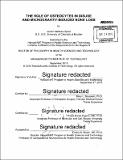| dc.contributor.advisor | Mary L. Bouxsein and Paola Divieti Pajevic. | en_US |
| dc.contributor.author | Spatz, Jordan Matthew | en_US |
| dc.contributor.other | Harvard--MIT Program in Health Sciences and Technology. | en_US |
| dc.date.accessioned | 2016-02-29T15:01:09Z | |
| dc.date.available | 2016-02-29T15:01:09Z | |
| dc.date.copyright | 2015 | en_US |
| dc.date.issued | 2015 | en_US |
| dc.identifier.uri | http://hdl.handle.net/1721.1/101338 | |
| dc.description | Thesis: Ph. D., Harvard-MIT Program in Health Sciences and Technology, 2015. | en_US |
| dc.description | Cataloged from PDF version of thesis. | en_US |
| dc.description | Includes bibliographical references. | en_US |
| dc.description.abstract | A human mission to Mars will be physically demanding and presents a variety of medical risks to crew members. It has been recognized for over a century that loading is fundamental for bone health, and that reduced loading, as in prolonged bed rest or space flight, leads to bone loss. Osteocytes, the most abundant bone cell type, are thought to be key mechanical sensors in bone, yet the molecular mechanism of this action remains poorly understood. Improved understanding of how osteocytes regulate skeletal responses to mechanical loading and unloading could have significant implications for treatment of bone disorders related to disuse or immobilization. Thus, we conducted in vitro and in vivo studies on osteocytes exposed to unloading to investigate their role in disuse and microgravity-induced bone loss. Specifically, we generated and characterized a novel osteocytic cell line that recapitulates the response to hormonal and mechanical stimuli of osteocytes in vivo. This novel cell line provided the first evidence of a cell-autonomous increase in sclerostin, a potent inhibitor of Wntsignaling, following exposure to simulated microgravity. These cells were also used for a spaceflight mission after demonstrating their ability to maintain an osteocytic phenotype when cultured in a fully automated flight-certified system. Finally, we utilized murine models of unloading to show that pharmacologic inhibition of sclerostin induces bone formation and prevents disuse-induced bone loss. | en_US |
| dc.description.statementofresponsibility | by Jordan Matthew Spatz. | en_US |
| dc.format.extent | 155 pages | en_US |
| dc.language.iso | eng | en_US |
| dc.publisher | Massachusetts Institute of Technology | en_US |
| dc.rights | M.I.T. theses are protected by copyright. They may be viewed from this source for any purpose, but reproduction or distribution in any format is prohibited without written permission. See provided URL for inquiries about permission. | en_US |
| dc.rights.uri | http://dspace.mit.edu/handle/1721.1/7582 | en_US |
| dc.subject | Harvard--MIT Program in Health Sciences and Technology. | en_US |
| dc.title | The role of osteocytes in disuse and microgravity-induces bone loss | en_US |
| dc.type | Thesis | en_US |
| dc.description.degree | Ph. D. | en_US |
| dc.contributor.department | Harvard University--MIT Division of Health Sciences and Technology | |
| dc.identifier.oclc | 938897490 | en_US |
